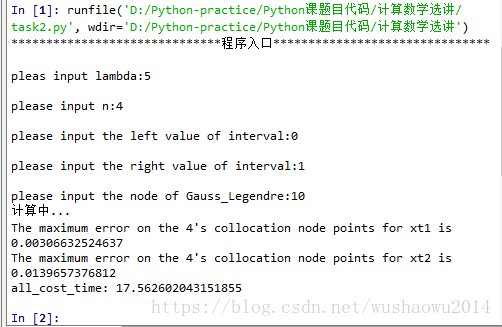这是《The Numerical Solution of Integral Equations of the Second Kind》书上的例题代码实现,P59-61。如有您发现有问题,欢迎指出,,,
# -*- coding: utf-8 -*-
"""
Created on Tue May 29 12:37:44 2018
@author: shaowu
本代码主要运用collocation method实现Fredholm integral equations of the second kind的求解,方程如下:
lamda*x(t)-integrate(K(t,s)*x(s))ds=y(t),a=0<=t<=b,K(t,s)取exp(s*t)
首先,我们给定两个精确解exp(-t)cos(t)和sqrt(t),求出其对应的y(t),然后再来反解x(t).更详细说明可
参见《The Numerical Solution of Integral Equations of the Second Kind》P59-61.
"""
import sympy as sp
import scipy as scp
import numpy as np
import pandas as pd
import numpy.linalg as LA
import matplotlib.pyplot as plt
from scipy.special.orthogonal import p_roots
import time
start_time=time.time()
def gauss_xw(m=10):
"""
默认用10个点求高斯——勒让德节点xi和权weight,并返回x和w数组
"""
x,w=p_roots(m+1)
return x,w
def gauss_solve_y(x,w,lamda,a,b,n): #参数n>=1
"""
求解课本3.2.41式中的右端项y(ti).
method:gauss_Legendre
参数:
x,w为高斯点和对应的权,
a,b 对应于区间[a,b],
n 子区间的个数
返回的是一个n+1维的列表
"""
c=(b-a)/2
s=(b-a)/2*x+(a+b)/2 #把区间[a,b]变化到[-1,1]
h=(b-a)/(n)
t=[a+i*h for i in range(0,n+1)] #等距划分a=t0<t1<...<tn=b
return [(lamda*scp.exp(-i)*scp.cos(i)-
sum([c*w[j]*scp.exp(s[j]*i)*scp.exp(-s[j])*scp.cos(s[j]) for j in range(len(s))]))
for i in t],\
[(lamda*scp.sqrt(i)-
sum([c*w[j]*scp.exp(s[j]*i)*scp.sqrt(s[j]) for j in range(len(s))]))
for i in t]
def hat_f(j,x,a,b):
"""
定义hat函数
"""
h=(b-a)/(n)
t=[a+i*h for i in range(0,n+1)]
if j==0:
if x>=t[0] and x<=t[1]:
return 1-abs(x-t[0])/h
else:
return 0
if j==n:
if t[n-1]<=x and x<=t[n]:
return 1-abs(x-t[n])/h
else:
return 0
if j>0 and j<n:
if t[j-1]<=x and x<=t[j+1]:
return 1-abs(x-t[j])/h
else:
return 0
def elements_of_matrix(x,w,i,j,t,a,b,n):
"""
对K(t,s)*lj(s)在[a,b]上求积分,即等式(3.2.41)中的积分项;
返回的是一个数,即对应系数矩阵中的一个元素
"""
h=(b-a)/(n)
if j==0:
#c=h/2;s=h/2*x+(t[0]+t[1])/2 #区间变化
return -scp.integrate.quad(lambda x: (x-t[0])*scp.exp(t[i]*x),t[0],t[1])[0]/h
#return -sum([w[k]*c*hat_f(j,s[k],a,b)*scp.exp(t[i]*s[k]) for k in range(len(s))])
elif j==n:
#c=h/2;s=h/2*x+(t[n-1]+t[n])/2 #区间变化
return -scp.integrate.quad(lambda x: (t[n]-x)*scp.exp(t[i]*x),t[n-1],t[n])[0]/h
#return -sum([w[k]*c*hat_f(j,s[k],a,b)*scp.exp(t[i]*s[k]) for k in range(len(s))])
else:
#c=h;s=h*x+(t[j-1]+t[j+1])/2 #区间变化
return -scp.integrate.quad(lambda x: (x-t[j-1])*scp.exp(t[i]*x),t[j-1],t[j])[0]/h-\
scp.integrate.quad(lambda x: (t[j+1]-x)*scp.exp(t[i]*x),t[j],t[j+1])[0]/h
#return -sum([w[k]*c*hat_f(j,s[k],a,b)*scp.exp(t[i]*s[k]) for k in range(len(s))])
def solve_xn(x,w,lamda,a,b,n,y1,y2):
"""
计算xn1和xn2
返回xn1和xn2(一个n+1维的列表)
"""
xn=[]
h=(b-a)/(n)
t=[a+i*h for i in range(0,n+1)] #等距划分a=t0<t1<...<tn<tn+1=b
#A.append([-scp.integrate.quad(lambda x:(1-abs(x-t[j])/h)*scp.exp(t[0]*x),t[0],t[1])[0] for j in range(n+1)]) #计算i=0时的
for i in range(0,n+1):
#guodu=[-scp.integrate.quad(lambda x:(1-abs(x-t[0])/h)*scp.exp(t[i]*x),t[0],t[1])[0]]+\
guodu=[elements_of_matrix(x,w,i,j,t,a,b,n) for j in range(0,n+1)]#+\
# [-scp.integrate.quad(lambda x:(1-abs(x-t[n])/h)*scp.exp(t[i]*x),t[n-1],t[n])[0]]
xn.append(guodu)
#A.append([-scp.integrate.quad(lambda x:(1-abs(x-t[j])/h)*scp.exp(t[n]*x),t[n-1],t[n])[0] for j in range(n+1)]) #计算i=n时的
xn=np.array(xn)
for i in range(n+1):
xn[i][i]=lamda+xn[i][i]
result1=np.linalg.solve(xn,y1) #求解xn1
result2=np.linalg.solve(xn,y2) #求解xn2
return result1,result2
def solve_error(lamda,a,b,n,xn1,xn2):
"""
计算最大误差,并返回
"""
h=(b-a)/(n)
t=np.array([a+i*h for i in range(0,n+1)])
#tt=np.array([i for i in np.arange(a+0.1,b,0.1)])
xt1=scp.exp(-t)*scp.cos(t) ##第一个精确解xt1
xt2=scp.sqrt(t) ##第二个精确解xt2
#E1=LA.norm(xt1-xn,np.inf) ##计算无穷范数
E1=max(abs(xt1-xn1))
#E2=LA.norm(xt2-xnt2,np.inf)
E2=max(abs(xt2-xn2))
print('The maximum error on the %d\'s collocation node points for xt1 is %s'%(n,E1))
print('The maximum error on the %d\'s collocation node points for xt2 is %s'%(n,E2))
"""
#画图
plt.figure(1)
plt.subplot(211)
plt.title('Figure1.(where a=0,b=1,n=128,lambda=5)')
plt.xlabel('t')
plt.ylabel('x')
plt.plot(t,xt1,'*--',t,xn1,'-')
plt.subplot(212)
plt.plot(t,xt2,'--+',t,xn2,'-')
"""
return E1,E2
if __name__ == '__main__':
print('******************************程序入口*******************************')
lamda=int(input('pleas input lambda:'))
n=int(input('please input n:')) # n>0 为配置点个数
a=int(input('please input the left value of interval:'))
b=int(input('please input the right value of interval:'))
m=int(input('please input the node of Gauss_Legendre:'))
print('计算中...')
x,w=gauss_xw(m)
y1,y2=gauss_solve_y(x,w,lamda,a,b,n)
xn1,xn2=solve_xn(x,w,lamda,a,b,n,y1,y2)
E1,E2=solve_error(lamda,a,b,n,xn1,xn2)
print('all_cost_time:',time.time()-start_time)运行结果:

























 1155
1155

 被折叠的 条评论
为什么被折叠?
被折叠的 条评论
为什么被折叠?








